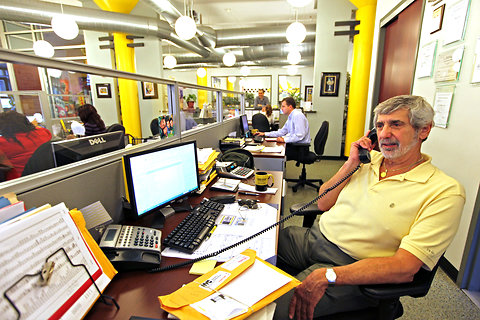
The sale of two taxi medallions priced at $1 million each was brokered by Nat Goldbetter at Queens Medallion Brokerage Corporation in Long Island City.
The million-dollar taxicab is here.
Two New York City taxi medallions ¡ª tin plates that grant the right to operate a yellow cab ¡ª changed hands on Wednesday for $1 million apiece, the highest recorded sale since the city¡¯s modern livery system began.
The sale was the culmination of decades of astonishing growth for the humble medallion, which is literally nailed to the hood of every yellow cab in the city. When New York issued its first batch of medallions in 1937, the going price was $10 even, or $157.50 in today¡¯s dollars.
Some perspective: The Dow Jones industrial average has risen 1,100 percent in the last 30 years. In the same period, the value of a taxi medallion is up 1,900 percent. That return beats gold, oil and the American house.
Sky-high prices and million-dollar deals seem a far cry from the medallion¡¯s early days; when World War II came around and demand for taxis dropped, many drivers simply returned their medallions to the city to avoid the annual $10 renewal fee.
¡°It¡¯s a lot of money, and it is an investment that someone would not make without being confident in the industry and the future of the city,¡± said David S. Yassky, chairman of the city¡¯s Taxi and Limousine Commission.
The man who brokered Wednesday¡¯s sale, a taxi financing specialist named Nat Goldbetter, grew up on the Lower East Side and got into the taxi business in the 1960s as a driver. He bought his own medallion in 1969 for $25,000, but sold it a few years later. ¡°I could have made a zillion dollars, but I did O.K.,¡± he said.
The million-dollar sale was hatched earlier this year, when Mr. Goldbetter received a visit from an old acquaintance looking to sell two medallions purchased for $80,000 apiece in the 1980s. There was an offer that valued each medallion at $975,000, but the seller was hoping for more.
With many owners reluctant to sell these days, hoping for the value to keep going up, Mr. Goldbetter figured he could find a willing buyer. The papers were signed on Wednesday morning.
¡°Nobody ever thought the medallion would get to this point,¡± Mr. Goldbetter said on Wednesday from his office in Long Island City, Queens, a few hours after the papers were signed. ¡°It was pretty cool. It broke up the boredom of my work.¡±
Mr. Goldbetter, a youthful looking 67, was no stranger to the historic: In 1985, he handled the sale of the first $100,000 medallion, a feat that earned a front-page article in The New York Times.
¡°It¡¯s kind of history repeating itself, only multiplied by 10,¡± Mr. Goldbetter said.
There are 13,237 medallions in the city; new ones, when issued, are sold at auction. Large fleets, which can control hundreds of medallions, often find it easy to secure financing to meet the high prices. Medallion sales can make for big business: the biggest lender, Medallion Financial, is a publicly traded company (ticker symbol: TAXI) and shares its skyscraper on Madison Avenue with the Rockefeller Family Fund.
Corporate medallions, like the two sold on Wednesday, do not need to be driven by their owners and can be leased out 24 hours a day. Individual medallions, which make up about 40 percent of the fleet and must be occasionally driven by the owner, are worth slightly less: the latest sale was for about $700,000.
The secondary market in medallions and its private transfers began after World War II, at the starting price of $2,500. The value quickly grew, crossing the $50,000 mark in the mid-1970s. But the steepest period of growth has been over the past decade, when the value of corporate medallions nearly quadrupled.
So are we entering the tulip era of the taxicab? Could a million-dollar sale signal the beginning of the end of the great yellow cab bubble?
¡°No one is very good at forecasting the economic future right now, but I would say no,¡± said Graham Hodges, a professor at Colgate who has written a history of the taxi industry. He said the investment in a medallion is comparable to purchasing an apartment in Manhattan.
¡°It will always make good money and pay for itself,¡± Mr. Hodges said. ¡°There are certain things that are just gilt-edged assets, and this is one of them.¡±
As for the first $100,000 medallion, it was sold to a young immigrant from Hong Kong named Stanley Cheung. In 1985, he told The Times that he heard medallion values were on the rise, and if the price kept going up, he might sell. ¡°There are things better than driving a cab,¡± he said.
Mr. Cheung did indeed sell his medallion: in 1987, for $125,000. After paying the expenses for his cab, Mr. Cheung came out about even, according to his wife, Shirley Cheung, who was reached on Wednesday at the couple¡¯s house in Little Neck, Queens.
¡°One million? Oh my God!¡± Ms. Cheung said, when informed about the recent sale. ¡°I don¡¯t want to hear about it. I have to sleep tonight.¡±
Ms. Cheung laughed, and said that she was well aware that medallion values had skyrocketed in recent years. Her husband, she said, looks at the prices every once in awhile, but she tells him not to share. ¡°It¡¯s O.K.,¡± she said of the high value. ¡°I just don¡¯t want to hear about it.¡±
